 Nuclear-powered ballistic missile submarines (1958-61), service 1961-1990: Ethan Allen, Sam Houston, Thomas A. Edison, John Marshall, Thomas Jefferson (SSBN-608 – 618)
Nuclear-powered ballistic missile submarines (1958-61), service 1961-1990: Ethan Allen, Sam Houston, Thomas A. Edison, John Marshall, Thomas Jefferson (SSBN-608 – 618)Cold War US Subs
GUPPY | Barracuda class | Tang class | USS Darter | T1 class | X1 class | USS Albacore | Barbel classUSS Nautilus | USS Seawolf | Migraine class | Sailfish class | Triton class | Skate class | USS Tullibee | Skipjack class | Permit class | Sturgeon class | Los Angeles class | Seawolf class | Virginia class
Fleet Snorkel SSGs | Grayback class | USS Halibut | Georges Washington class | Ethan Allen class | Lafayette class | James Madison class | Benjamin Franklin class | Ohio class | Colombia class
The Ethan Allen class were five ballistic missile submarines (SSBN) which directly eveolved from the George Washington class. The class comprised Ethan Allen, Sam Houston, Thomas A. Edison, John Marshall, and Thomas Jefferson. With the previous George Washington and next Lafayette, Madison, Franklin classes they formed the “41 for Freedom” instrumental in the US nuclear deterrent force until the SALT treaties and end of the cold war. Designed “from the keel up” for the first time, they were tailoted to carry the Polaris A-2 missile were longer, more streamlined, doove deeper thanks to a better steel, and had four torpedo tubes instead of six, and a better fire control system. They were also updated to the Polaris A3, but could not accomodate the larger Poseidon. With the SALT treaties signed in the 1980s they were all modified as SSNs but only for a short service. One served as a SEAL spec ops boat for longer, until 1993. #ussethanallen #usnavy #unitedsttesnavy #ssbn #strategicsubmarines #usdeterrence #polaris #coldwar

USS Sam Houston in Hawaii 1990
Development of SBC 180
After the Regulus Program
In 1950 the USN contested the monopoly of the US Air Force on strategic deterrence and wanted to take a part, at first working on twin-engine bombers launched from carrier decks with atomic bombs. But this was killed in the egg by the Strategic Air Command under Curtis LeMay. Thus inter-service rivalry bounced with the USS United States but political pressure, despite the “revolt of the admirals” put an end to this and consecrated the USAF as go-to solution for deterrence. At the same time many in the Navy thought that marrying missiles with submarines was a good, if not better alternative as air power was conspicious.
This faction gained momentum between the development of atomic power for propulsion and the Navy’s own missile programmes. The idea of fitting cruise missiles, nuclear tipped on ramps ermerged as a good stopgap until the first ballistic missiles would be ready. After tests made on WW2 vets USS Tunny and USS Barbero the Regulus cruise missiles program took off. They were the first to undertake navy’s deterrent patrols. Next the navy tested the SSGN USS Halibut.
But alongside the six boats converted for such experiments, the missile department continued its pioneering work and made progresses.
The first SSBNs
After acquiring the bomb in 1949, developing intercontinental bombers the next step were Soviet SSGNs and SSBNs, starting with the “bin” Whiskey class conversions, the Golf class launched from 1957 and the nuclear powered Hotel class launched from 1959. In between the USN had its Georges Washington class unveiled. They were a far better proposition with 16 hull-mounted missiles launched underwater instead of three launched surfaced from a sail. But for this, the USB had to cut corners. To gain time, the Skipjack class SSNs were taken as a base, simply stretched into include 8 missile tubes in two rows. Supplemnentary Skipjack class were taken over and converted, giving birth to the first Georges Washington class SSBNs.
The Polaris Program
But nothing would have been possible without the Polaris program, at first to replace the mediocre sea variant of the US Army “Jupiter”. In fact the latter were so large there was only possible to stack four tubes in the sail, and all liquid-fueled. Rear Admiral W. F. “Red” Raborn created under the CNO (Arleigh Burke) a Special Project Office to push fora better model and meanwhile Project Nobska in 1956 pushed for a better model, which became the Polaris missile, led by Edward Teller (Manhattan project). It was far more compact and could be fitted into the hull, as well as launched underwater. In December Jupiter was dropped for Polaris and the team worked out a way to have 16 missiles launched from underwater as asked for in 1955. Working around the clock until 1958 Raborn presented to Burke the result, later congratulated by Eisenhower as the USN took the lead in naval deterrence over the Soviet Union, which had to catch up many years later (1965) with the Yankee class.
Design and Construction
The process to design the Ethan Allen followed the one adopted for the Georges Washington class by exchanges between the admiralty board (BuOrd) and BuShips on 31 December 1957. Electric Boat created a final design, and the Skipjack hull was taken as base, some of the class being requisitioned for conversion. USS Scorpion (SSN-589), USS Sculpin (SSN-590) were the first (one of the first name was completed as SSN and later sank). USS Georges Washington was converted on slip as SSBN-598 from USS Scorpion and laid down twice as her keel was elongated by a new section containing all eight sections of two missile silos each aft of the sail. The new Georges Washington, would be much longer at 381.6 ft long overall (116.3 meters) with the same 33 ft (10 m) beam. USS Sculpin became USS Patrick Henry, USS Scamp became USS Theodore Roosevelt, and two more were ordered FY1959, as Robert E. Lee (SSBN-601) at Newport News and Abraham Lincoln (SSBN-602) at Portsmouth, boh using unusde material planned for the Skipjacks, but laid down as SSBNs. USS George Washington was commissioned on 30 December 1959.
But it was clear that already this improvized class needed enchancements and improvements, leading to the design of a second class of tailored SSBNs, albeit based on the first design. Rather than take a Skipjack-class design with an extra missile compartment, the new Ethan Allen class under Navy hull design SCB 180 were designed as a ballistic missile launch platforms from the keel up. The hull was to be constructed from the improved HY80 steel for the first time, which had a high yield of 80,000 psi (550,000 kPa) strength. They also had to be equipped with the newly developed Mark 2 Mod 3 Ships Inertial Navigation System (SINS).
In addition they came out not with the Polaris A-1 but its successor, the A-2 (UGM-27B) SLBM as well as the Mark 16 Mod 6 torpedoes but with the new torpedo fire control system Mark 112 Mod 2. The A-2s later woould be replaced by the Polaris A-3, with an high pressure air ejection launch gear in the silos. The fire control system was upgraded to the Mark 80 in 1965 and the Polaris A-3Ts arrived in the 1970s, keeping this class relevant notably with the adoption of the Mark 37 and (later) Mark 48 torpedoes. Taklskibng about armament another major difference with the previous class designed from the Skipjacks, which had six bow tubes, was to instead adopting four tubes, placed further down to accomodate a large sonar above. This was a reduction logical for a SSBN as these tubes were mostly for self defence.
Design of the class
Hull and general design

The new hull was still inspired by the previous Skipjack-based G. Washingtons, and retained the same, albeit more streamlined ballistic missile section behind the sail of 130 ft (40 m), with refined “shoulders” at the base of the sail. The “hump” went down aft, blending way better with the hull which was rehaped precisely in order to be more flushed and streamlined, both for extra speed and acoustic benefits.
The reactor was placed aft of the missile bay and remained the trusted G3W. Accomodations were modified as well as the bow, with four tubes and a large sonar room above, and finer entry lines. Like the Washingtons, the Ethan Allen had to have two crews (Blue and Gold) succeeding each other for alternated deterrence patrols. Their crew was even larger than the Washingtons at 12 officers and 128 enlisted men for each so 256 instead of 228 men. The new Ethan Allen ended longer and heavier than the Washingtons. They displaced 6,955 long tons (7,067 t) surfaced and 7,880 long tons (8,010 t) submerged versus 5,959 long tons (6,055 t) and 6,709 long tons (6,817 t). That was an increase of more than 1000 tonnes; quite significant, and explained in part by their longer hull, at 410 feet 4 inches (125.07 m) versus 381 feet 6 inches (116.3 meters), a Beam of 33.1 feet (10.1 m) versus 33 feet (10 m) so slight increase here, and a draft of 27 feet 5 inches (8.36 m) instead of 29 feet (8.8 m).
As completed USS Ethan Allen and her sisters were painted in two tones, black upper livery with a light navy medium grey on top, and red hull down the waterline as primer. Like fo the Washingtons, there were two safety hatches at both ends with an escape room, three entry hatches. The Command Center was a repeat, but with modifications and the sail adopted the style of the longer variant of the old Skipjack’s sail, after modifications on the Washingtons for extra stability.
Powerplant
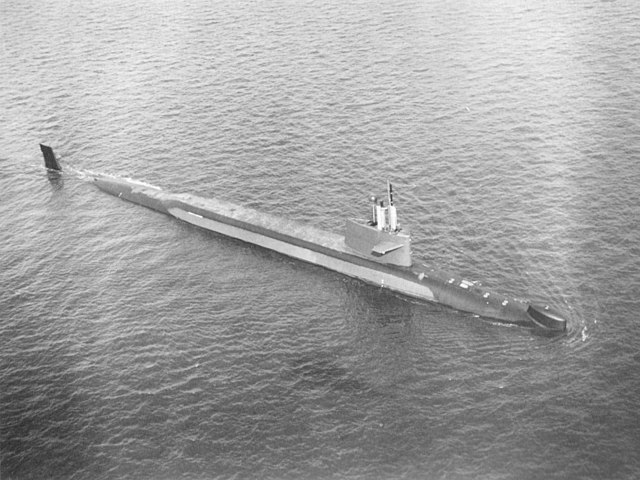
USS Thomas A Edison underway, note the 1962 initial livery mixing gray and black on the upper hull.
The Ethan Allen class also innovated compared to the previous Washingtons, which just retook wihout change the Skipjack’s single S5W Pressurised Water Reactor, coupled with two 2 geared steam turbines (15,000 shp (11,000 kW)), turning a single shaft with a 7-bladed bronze propeller on a same cross tail. In addition to the same S5W PWR, the Ethan Allen class’s geared steam turbines developed the exact same 15,000 shp. No change here, and a stop speed when surfaced of 16 knots (30 km/h) and 22 knots (41 km/h) submerged, same as the Washingtons. But the innovation was in the stronger hull, which enabled a greater depht capacity at 1,300 feet (400 m) instead of 700 ft (210 m). That was basically twice as much and an enormous advantage if caught by Soviet ASW forces. No submarine at the time was capable of diving this low. The later Soviet Yankee class were indeed “only” capable of 300 m (985 m). Range was the same, and unlimited except for food supplies. To allievate this, there was the use of two crews which came out with fresh food supplies and the capability of performing both crew swaps and supplies at any point on the globe.
Armament
Main: 16x UGM-27B Polaris A2 SLBMs
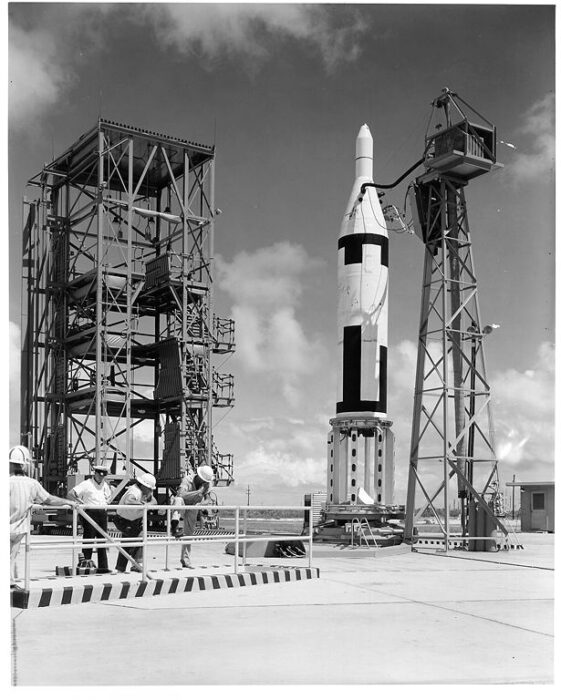
The main asset of the Ethan Allen remained that “broadside” of sixteen UGM-27 ballistic missiles, still carrying at that stage a single warhead with a W47 thermonuclear bomb in a reentry vehicle atop the missile. But unlike the Washington class, the Ethan Allen swapped directly to the new version A2 of the Polaris. Read bout the full development of the Polaris and the teams working behind on the previous post.
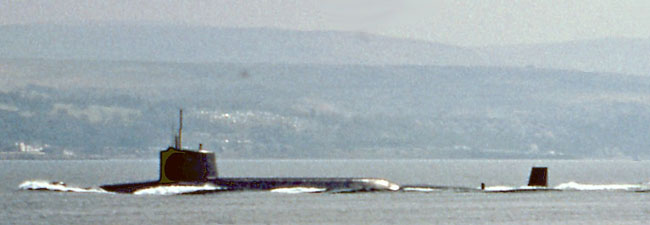
The UGM-27B or Polaris A2 was under development in 1959 just as the A1 became operational. It had a lenghtened body by three feet to better fill out the tubes and had a new Hercules second stage engine with glass filament-wound casing instead of steel (A1). The engine had a rotary nozzle for thrust vector control. It was first carried by the five Ethan Allen Class wheeras the next Lafayette Class had eight outfitted with Polaris A2 and the remainder with the improved Polaris A3 and Poseidon.
The A2 was quite an improvement over the A1 (range 1,400 nautical miles or 2,600 kilometres) but the same single Mk 1 re-entry vehicle. The A-2 had indeed a 1,700-mile (2,700-kilometre) range and one-megaton warhead. The W-47-Y2 however had reliability problems and just 300 were produced and maintained in service, then post-1966 all were inspected and internals redone anew.
The Polaris A2 was retired in September, 1974 and the remainder in stock ended in anti-missile tests. Only one was ever used in a live nuclear test. This was a clear message to Moskow, which arrived at the time of the Cuban crisis. They sawpped to the Polaris A3 in the 1970s along with their major overhaul sechedule. In 1981, all subs in class had their Polaris A-3 removed according to SALT treaties. The tubes were filled with concrete to keep some ballast.
⚙ specifications Polaris A2 SLBM |
|
| Weight | 38,000 lb (17,500 kg) |
| Dimensions | 30 ft, 9 in x 4 ft, 6 in |
| Propulsion | Two solid-fueled stages, reactor |
| Speed | 8,000 mph (13,000 km/h) |
| Range | 1,727 miles (2,700 km) |
| Guidance | Inertial, satellite, see notes. |
| Ceiling | Stratposphere, pre-orbital |
| Accuracy | CEP c1,500 meters (4,500 feet) |
| Payload | W47 Y2, 1.2 Mgt yeld Y2 |
Torpedo Tubes
Unlike the Washingtons, that kept all six 21-inch (533 mm) torpedo tube and a reserve lowered at 12 torpedoes, one per Mk 59 tube, the Ethan Allen class had two upper tubes removed, and the remainder pushed a bit lower in the bow chin. They were still initially of the same model, to carry the 1957 Mark 37 torpedoes (see the Washingtons for extra data).
However the Mark 59 were replaced by Mk 65 tubes and they kept the same 12 torpedo reserve. The main change was in the new torpedoes developed at the time. They indeed adopted the Mark 16 Mod 6 torpedoes initially, basically a modernized version of a 1943 design to replace the infamous Type 14. They were rugged and reliable, but not technologically advanced.
The Mark 37 replace these until themselves were replaced by the Mark 48.
Sensors
These SSBNs had about the same suite as the Washingtons, albeit upgraded: They sported the BPS-9 radar, and the BQS-4A, BQR-7, BQR-15, BQR-19 sonars
BPS-9 radar
The AN/BPS-9 is a medium-range surface search and navigation radar searching in the X-band or I-band. She was only seen on the Ethan Allen class ans USS Tullibee.
Frequency 8,740 to 8,890 MHz (X-band). Pulse repetition frequency (PRF) 540 to 660 Hz
pulsewidth 0.5 µs, P Power 50 to 110 kW, range 80 NM (148 km). Beamwidth 2.6°, max 8 r.p.m.
BQS-4A sonar
The BQS-4 was active sonar, here in its latest variant. The AN/BQS-4 is an active/passive detection sonar consisting in the AN/BQR-2 passive detection system and added active detection capability.
The BQS-4 active component comprised seven vertically stacked cylindrical transducers, located inside the BQR-2 chin bow dome to transmit its active “pings.”
In addition to passive listening, it can operate in either automatic echo-ranging or “single-ping” modes.
BQR-7 sonar
The AN/BQR-7 sonar is a long-range passive equipment installed on 594-class nuclear submarines. Target signals are recorded contiruously on a bearing-time-recorder display. A steered-beam audio display is also available for tracking one target at a time. The bearing of a particular target can be read from a dial on the operator’s console and the data can be transmitted automatically to the fire control system.
The hydrophones for the BQR-7 sonar are mounted in vertical staves, in groups of three, in a horseshoe configuration conforming to the shape of the submarine’s bow. There are 156 hydrophones
organized into 52 staves. Each stave has its individual amplifier for boosting the received signal. There are two independent compensator switches in the system. One compensator swit- feeds the BTR from the output of a continuously scanning beam rotated at a preset rate. The other switch, which is manually positioned, controls a narrow beam which presents the audio signal to the operator.
One compensator can automatically sweep and record target signals on the BTR while the other is used for manual search detection and tracking, The audio beam is trained in azimuth by a “steering wheel” control mounted on the console. The effectiveness of the BQR-7 passive sonar is reduced by own-ship noise during high-speed cruising. This apparently becomes critical over 5-6 knots.
The full description in a declassified document here
BQR-15 sonar
The AN/BQR-15 is a passive detection system including a thin line towed array (9080 line) coupled with the AN/BQR-23 signal processor. This array cable could be as long as 2,640 ft (800 m) long for a diameter of 0.5 in (12 mm). It is rolled down by a winch with hydraulic drive allowing the array to be streamed, retrieved or adjusted while submerged. It can be deployed in 15 minutes. This system was an upgrade in the late 1970s for the Ethan Allen class. It is part of the sonar suite carried by the the former SSBN-616 Lafayette class and current SSBN-726 Ohio class. More
BQR-19 sonar
Nicknamed “top hat”, this mast-mounted 1,000 pounds (454 kg) was an active, short-range and rapid-scanning submarine sonar for collision avoidance, navigation and other applications like upward-looking ice detection and mine detection. Its Initial operational capability (IOC) was attained in 1970 and it was deployed from the start on the OHIO-class submarines but also found its way on the upgraded Ethan Allen class.

USS Thomas Edison 1963, note the bicolor livery

Conways profile of the Ethan Allen class
⚙ Ethan Allen class spec. |
|
| Displacement | 6,946 long tons (7,057 t), Submerged 7,884 long tons (8,011 t |
| Dimensions | 410 ft x 33.1 ft 4 in x 29 ft 10 in (125.1 x 10.1 x 9.1 m) |
| Propulsion | 1 shaft S5W PWR 2x geared steam turbines (15,000 shp (11,000 kW)) |
| Speed | 16 knots (30 km/h) surfaced, 22 knots (41 km/h) submerged |
| Range | Unlimited except by food supplies |
| Armament | 16 Polaris A2/A3 missiles, 4 × 21-in (533 mm) TTs (12 torpedoes) |
| Sensors | BPS-12 radar, BQS-4A sonar, BQR-2 sonar |
| Test depth | 1,300 feet (400 m) |
| Crew | 2x 128 Blue/Gold (12 officers) |
Career of The G Washington class
 Ethan Allen (SSBN-608)
Ethan Allen (SSBN-608)
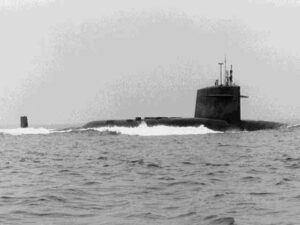 USS Ethan Allen (SSBN-608) was built at General Dynamics Electric Boat, laid down on 14 September 1959, launched 22 November 1960, completed on 8 August 1961 and commissioned under command of Captain Paul L. Lacy, Jr. (Blue Crew) and W. W. Behrens, Jr. (Gold Crew).
USS Ethan Allen (SSBN-608) was built at General Dynamics Electric Boat, laid down on 14 September 1959, launched 22 November 1960, completed on 8 August 1961 and commissioned under command of Captain Paul L. Lacy, Jr. (Blue Crew) and W. W. Behrens, Jr. (Gold Crew).
She was the lead boat of the first purpose-built American SSBN. On 6 May 1962 started Frigate Bird Test, part of Operation Dominic under Captain Lacy and with Admiral Levering Smith aboard: Shhe made the first ever live Polaris missile launch, detonating at 11,000 feet (3.4 km) over the South Pacific. She hit “right in the pickle barrel” USS Carbonero and USS Medregal 30 miles from the impact point for measurements.
She made patrols in the 1960s-70s but by the 1980s, as the Ohio-class came into service and under the limitations of SALT II, her missile tubes (plus her class) and those of the George Washington and were disabled. She became an attack submarine (SSN-608) on 1 September 1980 but saw little service in this title as she was decommissioned on 31 March 1983, stricken on 2 April 1983. Her hulk ended in Bremerton, Washington at the Nuclear Powered Ship-Submarine Recycling Program, completed on 30 July 1999.
She was featured in Tom Clancy’s novel “The Hunt for Red October” (1984), blown up as a decoy to convince the Russian Navy that the “Red October” (a fictional Typhoon M class) was destroyed.
 Sam Houston (SSBN-609)
Sam Houston (SSBN-609)
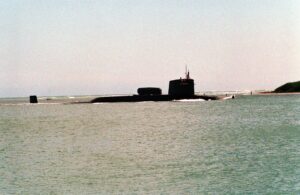 USS Sam Houston was laid down at Newport News Shipbuilding on 28 December 1959, launched on 2 February 1961 and completed on 6 March 1962 under command of Captain W. P. Willis, Jr. (Blue Crew) and Jack H. Hawkins (Gold). After her sea trials with the Blue Crew she fired her first Polaris missile (practice head) on 25 April 1962 off Cape Canaveral and for Gold, on 11 May, also off Cape Canaveral for her shakedown training.
USS Sam Houston was laid down at Newport News Shipbuilding on 28 December 1959, launched on 2 February 1961 and completed on 6 March 1962 under command of Captain W. P. Willis, Jr. (Blue Crew) and Jack H. Hawkins (Gold). After her sea trials with the Blue Crew she fired her first Polaris missile (practice head) on 25 April 1962 off Cape Canaveral and for Gold, on 11 May, also off Cape Canaveral for her shakedown training.
Her first patrol saw her submerged for 48 days, 2 hours. She sailed to her forward operating base in Holy Loch, Scotland, to tender USS Proteus (AS-19). Gold started her patrol 25 December, in Holy Loch by February 1963.
Later she became the first SSBN ever to enter the Mediterranean to join a NATO exercises with two 90 days rotations and six deterrent patrols in 1963. By late 1964 she made ten, four more in 1965, three by 1966 (with one of 71 days). She was back on 10 August 1966 for a major overhaul at Portsmouth until 30 October 1967 when she started her sea trials, and embarked Blue Crew for her shakedown training in November. In January 1968 Gold Crew followed, and she started her 18th deterrent patrol, entering Holy Loch on 25 May 1968. She concluded her 24th patrol in 1969 and from Submarine Squadron 14 she joined SunRon 16 in the Mediterranean from 9 August 1970, concluded in Rota, Spain.
On 27 November 1972 she entered Charleston for regular overhaul and upgades of all systems (notably new torpedoes and missiles). By February 1975 she completed sea trials and soon received blue crew for her post overhaul inspections and reassignment to the Pacific by late July. Gold (J.P Wiekert) crossed the Panama Canal in August to San Diego and receive armament at the Weapons Station Bremerton before heading for Pearl Harbor in early October. The 37th patrol was to Guam and 14 more patrols were made until 1979 from Guam. She also stopped in South Korea. In 1981 under SALT I she had her missile section deactivated, Concrete repalcing them for ballast, the missile fire-control system removed as the inertial navigation systems. She served as SSN-609 from 10 November 1980, used for training and secondary duties.
From September 1982 to September 1985 she was converted at Puget Sound Naval Shipyard as amphibious spec ops transport with a troop berthing, ballistic tube bases removed, conversion of the remainder into air locks, stowage adn she received on deck dry deck shelters abaft her sail to operate Navy SEAL team Swimmer Delivery Vehicles. On 29 April 1988 she ran aground on Fox Island, off Washington. She made a few special missions and was deactivated on 1 March 1991, seeing the collapse of the Soviet Union and the end of the cold war. She soon entered the Recycling Program at Puget Sound, decommissioned/stricken by 6 September 1991, Disposed of in late 1992.
 Thomas A. Edison (SSBN-610)
Thomas A. Edison (SSBN-610)
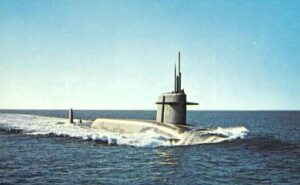 USS Thomas A. Edison was laid down at Electric Boat on 15 March 1960, launched on 15 June 1961 and completed on 10 March 1962 under Captains Charles M. Young (Blue) and Walter Dedrick (Gold). By 9 April 1962 in shakedown off the eastern coast she collided whole semi-submerged with the destroyer USS Wadleigh (DD-689) but damage was light.
USS Thomas A. Edison was laid down at Electric Boat on 15 March 1960, launched on 15 June 1961 and completed on 10 March 1962 under Captains Charles M. Young (Blue) and Walter Dedrick (Gold). By 9 April 1962 in shakedown off the eastern coast she collided whole semi-submerged with the destroyer USS Wadleigh (DD-689) but damage was light.
She loaded her sixteen Polaris A2 missiles at Charleston, started her first patrol on November 7, 1962, taking part in the Cuban Missile Crisis from October to November 1962. She even sailed on October 22, 1962, under DEFCON 3 alert level, ordered to “moved to her launch points and await instructions.” She ended in Holy Loch, and spent four years, 17 deterrent patrols there. In September 1966 she was homeported to New London, then Charleston, before her first major overhaul from 28 October 1966 until 9 May 1968. She had post-overhaul sea trials and shakedown and started her new patrol on 22 September 1968, then 19th patrol before ordered a “Follow on Target” test launch with four missiles selected at random, warheads removed and telemetry packages in place to measure the flight and accuracy. She launched off the Canary Islands into the Caribbean. Blue Crew eanred for this a Meritorious Unit Citation.
Until June 1973 she operated between New London and Rota with 19 more deterrent patrols in the Mediterranean. In June 1973 she was reassigned to the Pacific Fleet, San Diego, from 11 July, operations with SubGp 5, a short overhaul at Vallejo, California on 6 August and Mare Island until 30 November 1974. By February 1975 she crossed Panama for her live fire in March 1975 off Cape Canaveral, then back on the west coast on 8 August. In 1976 she was reassigned to Apra, Guam.
On 6 October 1980, she made her final deterrent patrol and under SALT I became SSN-610. By August 1982 she made her first WestPac as an ex-SSBN, stopping in Japan, Korea, Thailand and the Philippines. On 29 November 1982 while 40 miles (64 km) east of Subic Bay she collided with USS Leftwich (DD-984) in ASW exercises at periscope depth. Sail and sail planes were damaged but after this she never submerged again. Repaired at Guam, and Bremerton, she was home ported there. From January 1983, she entered Puget Sound for inactivation and was decommissioned on 1 December 1983, stricken 30 April 1986. She ended at the Submarine Recycling Program at Puget Sound from 1 October 1996 until 1 December 1997.
 John Marshall (SSBN-611)
John Marshall (SSBN-611)
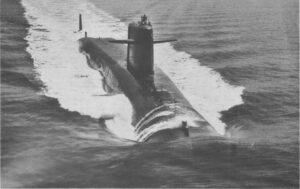 John Marshall was built at Newport News Shipbuilding and Drydock Co. 4, laid down on April 1960, launched on 15 July 1961 and commissioned on 21 May 1962 under Robert W. Stecher (Blue) and Robert D. Donavan (Gold). After sea trials from 8 April she was sent in the Atlantic on 21 May, assigned to SUBRON 14 and on the 31st started her shakedown cruise. On 12 July she launched two Polaris A-2 missiles (Blue) then three (Gold) off Cape Canaveral. In October, she stopped in İzmir (Turkey) being the first SSBN to visit a foreign port. On 31 December she started her first Polaris patrol (Blue) and from 4 April 1963 to 30 November 1966 she patrolled from Holy Loch in Scotland.
John Marshall was built at Newport News Shipbuilding and Drydock Co. 4, laid down on April 1960, launched on 15 July 1961 and commissioned on 21 May 1962 under Robert W. Stecher (Blue) and Robert D. Donavan (Gold). After sea trials from 8 April she was sent in the Atlantic on 21 May, assigned to SUBRON 14 and on the 31st started her shakedown cruise. On 12 July she launched two Polaris A-2 missiles (Blue) then three (Gold) off Cape Canaveral. In October, she stopped in İzmir (Turkey) being the first SSBN to visit a foreign port. On 31 December she started her first Polaris patrol (Blue) and from 4 April 1963 to 30 November 1966 she patrolled from Holy Loch in Scotland.
On 13 December 1966 she had a major overhaul at Newport News, until April 1968. By September 1968 she started her 18th patrol, and up to her 25th from Holy Loch until June 1970, joining SUBRON 16 from Rota in Spain, up to her 37th patro and awarded a first Meritorious Unit Commendation for her March 1971 performances. By June 1973 from New London she amde a dependents cruise, two patrols from from Charleston. On 1 November 1974 USS John Marshall had her second refueling overhaul at Mare Island, swapping to the Polaris A-3 missile, completed in May 1976, resuming her patrols by February 1977 in SUBRON 15, up to the 54th from Apra Harbor, Guam. She made her final patrol at Pearl Harbor on 28 December 1980.
On 12 January 1981 she became SSN-611, operating from Pearl Harbor. In Charleston on 20 July 1981 she joined SUBRON 4. On 28 December 1981 she was back in the Mediterranean with major fleet exercises and visits to La Maddalena, Naples, Tangiers, Lisbon and back to Charleston on 21 May 1982. In September 1983 she was transferred to the Pacific Fleet, Puget Sound for her third overhaul and just like USS Sam Houston (SSBN-609) she was modified to support SEAL operations as a mother ship. After trials in September 1985 she joined SUBRON 6 in Norfolk by November and in December 1986 transited to the Mediterranean with exercises and demonstrations, stops in Toulon, La Maddalena and back to Norfolk on 29 May 1987.
In September 1987, she made a demonstration near Puerto Rico (SEAL Team 2) alongside Aircraft carrier battlegroup exercises and later made her 1,000th dive on 25 October 1988.
On 1 May 1989,she sailed for her third Med Tod, she carried at the time the largest special warfare detachment in the Atlantic or Mediterranean. Later her crew was awarded by a second Meritorious Unit Commendation. Sje was back in Norfolk by September 1989, conducted three special warfare training exercises in 1990 and laid practice mines.
On 26 January 1991 she made her final Med TOD with two dry deck shelters, taking part in Operation Desert Storm for the 6th Fleet, stopping in Toulon, Gibraltar, La Maddalena and back on 22 June 1991. In September 1991 she became flagship for the largest submarine “special warfare” exercise since WW2, 191 spec operatives, SEALs, Army special forces, for joint special operations “Phantom Shadow”. She sailed to the Pacific in early 1992 for deactivation at Puget Sound, decommissioned, stricken on 22 July 1992. She went through the Submarine Recycling Program on 29 March 1993.
 Thomas Jefferson (SSBN-618)
Thomas Jefferson (SSBN-618)
 Thomas Jefferson (SSBN-618) Newport News Shipbuilding and Drydock Co. Jefferson was laid down on 3 February 1961, launched 24 February 1962 and completed on 4 January 1963 under Commanders Leon H. Rathbun (Blue) and Charles Priest, Jr. (Gold). After shakedown training she joined SUBRON 14 in early October 1963. First patrol started with blue crew from Holy Loch, reached on 28 October 1963, starting by December 1963. This went on for four years, as flagship. In 1966 she had a refit at New London and made her 15th patrol on 12 January 1967, then had her first major overhaul at Newport News until 17 June 1968, making her 16th deterrent patrol from 29 October, ending at Rota on 5 December 1968. 1969-1972 went on the same, but with special operations in 1970 and 1971. On 20 October 1972 “Gold” was awarded a Meritorious Unit Commendation. She made two more patrols in 1973 before back in the US another cruise with midshipmen 18 June-31 August. She made her 36th and final Atlantic-Med patorl from 31 January to 22 March 1974. After Norfolk and Charleston she was at New London on 22 May fore a refit, then reassigned to the Pacific, Vallejo, and Mare Island on 27 June.
Thomas Jefferson (SSBN-618) Newport News Shipbuilding and Drydock Co. Jefferson was laid down on 3 February 1961, launched 24 February 1962 and completed on 4 January 1963 under Commanders Leon H. Rathbun (Blue) and Charles Priest, Jr. (Gold). After shakedown training she joined SUBRON 14 in early October 1963. First patrol started with blue crew from Holy Loch, reached on 28 October 1963, starting by December 1963. This went on for four years, as flagship. In 1966 she had a refit at New London and made her 15th patrol on 12 January 1967, then had her first major overhaul at Newport News until 17 June 1968, making her 16th deterrent patrol from 29 October, ending at Rota on 5 December 1968. 1969-1972 went on the same, but with special operations in 1970 and 1971. On 20 October 1972 “Gold” was awarded a Meritorious Unit Commendation. She made two more patrols in 1973 before back in the US another cruise with midshipmen 18 June-31 August. She made her 36th and final Atlantic-Med patorl from 31 January to 22 March 1974. After Norfolk and Charleston she was at New London on 22 May fore a refit, then reassigned to the Pacific, Vallejo, and Mare Island on 27 June.
On 1 July 1974 she started her second major overhaul modernization at Mare Island, notably receving the Polaris A-3 until 17 November 1975. After trials off Bremerton, Washington, and fixes at Puget Sound she sailed to HP San Diego. By January-March 1976, Blue Crew led the post-overhaul shakedown and crossed Panama Canal to Cape Canaveral for Polaris tests. Back at San Diego in 1976 with Blue Crew aboard she had a complete energy loss, with fire and flooding causing a reactor scram, a procedural ORSE(Operational Reactor Safety Exam). The boat surfaced and came back under her own power to port. It was concluded she needed better training for the ORSE Board Examiners.
Gold went aboard on 4 April for more post-overhaul shakedown and another fire at Cape Canaveral, she loaded all her missiles at Bangor (Washington) and resumed deterrent patrols with the Pacific Fleet on 8 August, SUBRON 15 from 1977 to 1980 (51st patrol). On FY 1981 after SALT I treaty she saw her missile bay disabled, concrete blocks in, fire-control removed. She went on as SSN-618 on 11 March 1981, used for training and ASW exercises. She was decommissioned on 24 January 1985, stricken on 30 April 1986. She went through the Recycling Program at Bremerton from October 1996 to 6 March 1998.
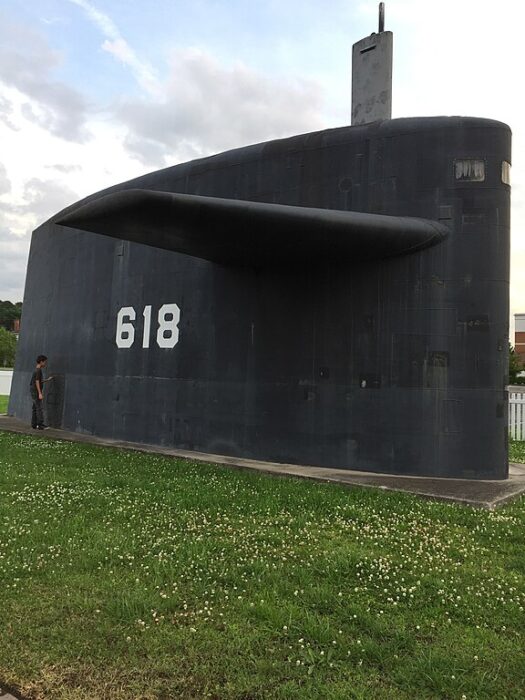
The sail was preserved in Gosport park , closed to the Norfolk Naval Shipyard in Virginia.
Read More/Src
SSBN-608 Ethan Allen-Class FBM Submarines” from the FAS”. Retrieved 25 November 2015.
Friedman, Norman (1994). U.S. Submarines Since 1945: An Illustrated Design History. Annapolis, NIP
Polmar, Norman (1981), The Ships and Aircraft of the U.S. Fleet (12th ed.), London: Arms and Armour Press
Gardiner, Robert; Chumbley, Stephen, eds. (1995), Conway’s All the World’s Fighting Ships 1947–1995, Annapolis, USA: Naval Institute Press, p. 612, ISBN 1-55750-132-7
California Center of Military History (dead link 2015-05-07) Archived 27 September 2013
Links
nationalinterest.org ethan-allan-class
on navysite.de/
on nuke.fas.org/
on spaceline.org/
on navypedia.org
on nuclearcompanion.com/
on navsource.org/
seaforces.org/
on en.wikipedia.org/
Videos
USS Ethan Allen SSBN 608 On Patrol
Model Kits
On scalemates, many kits
sdmodelmakers.com/
modelshipmaster.com



 Latest Facebook Entry -
Latest Facebook Entry -  X(Tweeter) Naval Encyclopedia's deck archive
X(Tweeter) Naval Encyclopedia's deck archive Instagram (@navalencyc)
Instagram (@navalencyc)





 French Navy
French Navy Royal Navy
Royal Navy Russian Navy
Russian Navy Armada Espanola
Armada Espanola Austrian Navy
Austrian Navy K.u.K. Kriegsmarine
K.u.K. Kriegsmarine Dansk Marine
Dansk Marine Nautiko Hellenon
Nautiko Hellenon Koninklije Marine 1870
Koninklije Marine 1870 Marinha do Brasil
Marinha do Brasil Osmanlı Donanması
Osmanlı Donanması Marina Do Peru
Marina Do Peru Marinha do Portugal
Marinha do Portugal Regia Marina 1870
Regia Marina 1870 Nihhon Kaigun 1870
Nihhon Kaigun 1870 Preußische Marine 1870
Preußische Marine 1870 Russkiy Flot 1870
Russkiy Flot 1870 Svenska marinen
Svenska marinen Søværnet
Søværnet Union Navy
Union Navy Confederate Navy
Confederate Navy Armada de Argentina
Armada de Argentina Imperial Chinese Navy
Imperial Chinese Navy Marinha do Portugal
Marinha do Portugal Mexico
Mexico Kaiserliche Marine
Kaiserliche Marine 1898 US Navy
1898 US Navy Sovietskiy Flot
Sovietskiy Flot Royal Canadian Navy
Royal Canadian Navy Royal Australian Navy
Royal Australian Navy RNZN Fleet
RNZN Fleet Chinese Navy 1937
Chinese Navy 1937 Kriegsmarine
Kriegsmarine Chilean Navy
Chilean Navy Danish Navy
Danish Navy Finnish Navy
Finnish Navy Hellenic Navy
Hellenic Navy Polish Navy
Polish Navy Romanian Navy
Romanian Navy Turkish Navy
Turkish Navy Royal Yugoslav Navy
Royal Yugoslav Navy Royal Thai Navy
Royal Thai Navy Minor Navies
Minor Navies Albania
Albania Austria
Austria Belgium
Belgium Columbia
Columbia Costa Rica
Costa Rica Cuba
Cuba Czechoslovakia
Czechoslovakia Dominican Republic
Dominican Republic Haiti
Haiti Hungary
Hungary Honduras
Honduras Estonia
Estonia Iceland
Iceland Eire
Eire Equador
Equador Iran
Iran Iraq
Iraq Latvia
Latvia Liberia
Liberia Lithuania
Lithuania Mandchukuo
Mandchukuo Morocco
Morocco Nicaragua
Nicaragua Persia
Persia San Salvador
San Salvador Sarawak
Sarawak Uruguay
Uruguay Venezuela
Venezuela Zanzibar
Zanzibar Warsaw Pact Navies
Warsaw Pact Navies Bulgaria
Bulgaria Hungary
Hungary

 Bundesmarine
Bundesmarine Dutch Navy
Dutch Navy Hellenic Navy
Hellenic Navy Marina Militare
Marina Militare Yugoslav Navy
Yugoslav Navy Chinese Navy
Chinese Navy Indian Navy
Indian Navy Indonesian Navy
Indonesian Navy JMSDF
JMSDF North Korean Navy
North Korean Navy Pakistani Navy
Pakistani Navy Philippines Navy
Philippines Navy ROKN
ROKN Rep. of Singapore Navy
Rep. of Singapore Navy Taiwanese Navy
Taiwanese Navy IDF Navy
IDF Navy Saudi Navy
Saudi Navy Royal New Zealand Navy
Royal New Zealand Navy Egyptian Navy
Egyptian Navy South African Navy
South African Navy






























 Ukrainian Navy
Ukrainian Navy dbodesign
dbodesign
Germany came up with several concepts of SSB and SSC submarines.. both with towed and integral mounts.. and capable of surfaced and submerged launchings..